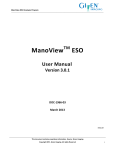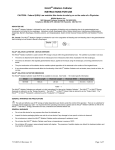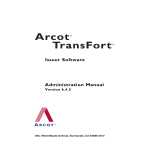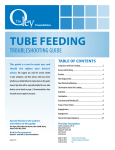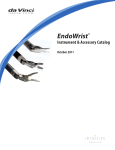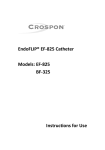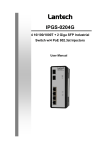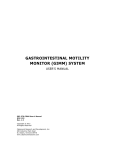Download EndoStim User Manual
Transcript
EndoStim Lower Esophageal Sphincter Stimulation Therapy Patient Manual Revision C 1588 EndoStim® is a registered trademark of EndoStim B.V. Read all accompanying documentation before using the device. Manufactured for: EndoStim B.V. Prinsessegracht 20 2514 AP The Hague The Netherlands The information contained in this document may be changed without notice. No part of this manual may be reproduced or transmitted in any way or by any means, either electronic or mechanical, for any purpose without the express written consent of EndoStim B.V. © EndoStim B.V. 2014 All Rights Reserved EndoStim Lower Esophageal Sphincter Stimulation Therapy 1 TABLE OF CONTENTS Overview ........................................................................................... 3 Indication ................................................................................................. 4 When the Device Should Not be Used (Contraindication) ..... 4 Precautions ............................................................................................. 4 Description of the Implantable Pulse Generator and Components ..................................................................................... 5 Implanting the EndoStim System ............................................. 6 Before Surgery ....................................................................................... 6 Surgery ...................................................................................................... 6 After Surgery .......................................................................................... 7 Follow Up ................................................................................................. 8 Potential Adverse Effects/Events............................................. 9 Implantation of the System ............................................................... 9 Use of the System .................................................................................. 9 Warnings and Precautions ......................................................... 9 Environmental Hazards ...................................................................... 9 Electrocautery ..................................................................................... 10 RF Ablation ........................................................................................... 11 Medical Diathermy ............................................................................ 11 Defibrillation ....................................................................................... 11 Therapeutic Radiation ..................................................................... 11 NMR and MRI Imaging ...................................................................... 12 Lithotripsy ............................................................................................ 12 Therapeutic and Diagnostic Ultrasound ................................... 12 Transcutaneous Electrical Nerve Stimulator .......................... 12 Home Appliances ............................................................................... 12 Anti-theft Systems.............................................................................. 13 Industrial Machinery ........................................................................ 13 Radio Transmitters ........................................................................... 13 Cellular Phones ................................................................................... 13 Airport Screening Systems ............................................................. 14 General Precaution ........................................................................... 14 Service and Warranty................................................................. 14 2 EndoStim Lower Esophageal Sphincter Stimulation Therapy Overview Your doctor has prescribed the EndoStim Lower Esophageal Sphincter Stimulation System to help treat gastro-esophageal reflux disease, sometimes called GERD. This manual will help you understand the system and how it treats gastro-esophageal reflux disease. The information in this manual is not intended to replace professional medical care that your doctor provides. If you have any questions, contact your doctor. Gastro-esophageal reflux disease is a condition that affects a small ring of muscle that is between the esophagus and the stomach. The ring of muscle is the lower esophageal sphincter (LES), and it allows food to pass into the stomach. When the muscle does not work properly, food and stomach acids can flow backward into the esophagus. Figure 1 shows you the differences between a functioning LES and one that does not function normally. Figure 1 Lower Esophageal Sphincter EndoStim Lower Esophageal Sphincter Stimulation Therapy 3 Indication ® The EndoStim Lower Esophageal Sphincter (LES) Stimulation System is intended for the treatment of patients with chronic gastroesophageal reflux disease (GERD) with symptom duration of 6 months or longer that has been shown to be refractory to pharmaceutical treatment. When the Device Should Not be Used (Contraindication) The EndoStim Lower Esophageal Stimulation System is contraindicated for individuals with the following conditions or needs: Significant cardiac arrhythmia, or ectopy, or significant cardiovascular disease. Pregnant or nursing. The following treatments are contraindicated for patients implanted with the EndoStim device: Magnetic Resonance Imaging (MRI) procedure Nuclear Magnetic Resonance (NMR) imaging procedure Medical diathermy TENS exposure in the abdominal region Precautions The EndoStim Lower Esophageal Sphincter Stimulation System has not been evaluated in the following populations. Patients with: Large (greater than 3 cm) hiatal hernia Severe Grade D esophagitis Long segment Barrett esophagus or Barrett esophagus with dysplasia Severe esophageal dysmotility Significant uncontrolled autoimmune disorder such as Scleroderma, Dematomyositis, CREST syndrome, Sjorgren’s syndrome, or Sharp’s syndrome, which effects esophageal motility Severe obesity with body mass index greater than 35 kg/m2 Type 1 diabetes mellitus 4 EndoStim Lower Esophageal Sphincter Stimulation Therapy Uncontrolled type 2 diabetes mellitus defined as HbA1c > 9.5 in the previous 6 months or has type 2 diabetes mellitus for more than 10 years Suspected or confirmed esophageal or gastric cancer Esophageal or gastric varices Dysphagia due to sever esophageal peptic structure, excluding Schatzki’s ring History of any active malignancy History of previous esophago-gastric surgery, e.g., laparoscopic fundoplication or an esophageal myotomy Pregnant Other implanted devices Younger than 21 years of age Significant psychiatric disorder that may interfere with therapy Description of the Implantable Pulse Generator and Components The EndoStim implantable pulse generator (IPG) is a small, metal case that the doctor implants in your abdominal area, just under the skin. (Figure 2) The IPG contains a battery that is permanently sealed inside the metal case. The doctor also implants a stimulating lead (electrical wires) that connects to the IPG. The IPG delivers electrical pulses through the lead. The electrical pulses provide stimulation to the lower esophageal sphincter. The programmable IPG communicates with an external device called a Programmer Medical and technical personnel use the Programmer to program parameters that control the IPG function. The doctor also uses the Programmer to retrieve information that the IPG collects during normal operation. The doctor uses a Programmer Wand to transmit information between the Programmer and the IPG. EndoStim Lower Esophageal Sphincter Stimulation Therapy 5 Figure 2 EndoStim LES Stimulator Implanting the EndoStim System Your doctor and healthcare team will explain the procedure for implanting the IPG and lead. The explanations may include what happens Before Surgery During Surgery After Surgery At Follow Up Before Surgery You may have blood drawn, diagnostic procedures, and other tests before your scheduled surgery date. Ask your doctor what tests they will require before implantation of your EndoStim IPG and lead. You will also meet with an anesthesiologist or surgeon prior to surgery. Your doctor may prescribe antibiotic treatment to protect against any infection that may occur after the procedure. Surgery The EndoStim IPG and lead will be implanted using general 6 EndoStim Lower Esophageal Sphincter Stimulation Therapy anesthesia. An anesthesiologist will monitor you and keep you asleep during the procedure. The doctor implants the IPG and leads in your abdominal area. The IPG goes inside a pocket that the surgeon creates just under your skin. The choice of the pocket site may depend upon how your body is shaped, and whether or not you have had any previous abdominal surgery. Most often, the surgeon performs laparoscopic surgery to implant the IPG and lead. Laparoscopic surgery is minimally invasive surgery, which means you may have four small incisions on your abdomen instead of a larger one. The surgeon inserts surgical instruments and the laparoscope through the incisions. A laparoscope is a flexible, tube-like instrument that connects to a camera so the surgeon can view the inside of the abdomen on a TV monitor. In some cases, the doctor may need more than 4 incisions. Or, depending on the circumstances, the surgeon may need to perform an open laparotomy, which means you will have one large incision. Your doctor will explain the advantages and risks associated with both types of surgery. The surgeon implants the lead first. The surgeon attaches the lead to the lower esophageal sphincter, and then connects the lead to the IPG. The IPG and any excess length of lead will be placed into a “pocket” created beneath the skin. You can discuss the exact location prior to surgery with your surgeon. The surgeon will then use sutures to close the incisions. The incisions will be covered with bandages. Your surgeon may recommend that you wear an elastic abdominal compression belt over the implant site for 30 days to minimize post-operative swelling or infection. The implantation procedure typically takes less than one hour. You may be able to go home within one day after surgery, but your surgeon will discuss what is best for you. After Surgery It is important to follow your surgeon’s instructions. The surgeon may advise you to avoid such activities as bending over or lifting anything heavy. The surgeon may advise you to gradually EndoStim Lower Esophageal Sphincter Stimulation Therapy 7 increase your walking distance once you return home. You may also receive instructions for bathing and how to keep your incisions dry. Note: It is recommended that you wear an elastic abdominal compression belt over the implant site for 30 days following implantation to minimize post-operative swelling or infection. Follow Up Your physician will schedule an appointment for your first follow-up office visit before you leave the hospital. Also, your healthcare team will keep in close contact with you during the first few weeks following implantation. Please attend your scheduled follow-up visits. During your recovery, you will need adequate rest. Avoid contact with individuals who may have infections or viruses. Avoid strenuous exercise for at least two weeks following your surgery. Your surgeon will discuss what is best for you. Recovery times vary among individuals, but most people recover fully within a few weeks. Call your surgeon if you are not feeling well, particularly if you have an elevated temperature or if you notice any redness, swelling, or drainage around your incision site. Avoid rubbing the skin above the implantation site against hard objects or sharp corners as this may damage the tissue. 8 EndoStim Lower Esophageal Sphincter Stimulation Therapy Potential Adverse Effects/Events Implantation of the System Potential adverse effects/events associated with the implantation of the IPG and lead include, but are not limited to, the following: death; pulmonary embolism; partial or complete ileus; peritonitis; esophageal perforation by the electrodes; infection; inflammation; injury to organs within the abdominal cavity; intravenous site complications; pneumonia; bleeding; incisional hernia; allergic or abnormal reaction to anesthetic agents; pain; and fever. Use of the System Adverse effects that could be associated with the EndoStim System include, but are not limited to, the following: lead/electrode dislodgement; lead erosion or perforation into the esophagus or stomach; IPG migration in the pocket; IPG erosion through the skin; diaphragmatic stimulation; stimulation of abdominal muscle; irritation and/or inflammatory response to the IPG and/or the lead; allergic reaction to materials; hematoma; infection; dysphagia; odynophagia; cardiac arrhythmia; nausea; and discomfort. LES stimulation ceases when the battery in the IPG is completely discharged. There is a potential that any system component could malfunction, become damaged, or infected. System component malfunction or other clinical circumstances (e.g., sepsis) may require noninvasive corrective actions or possibly even a surgical revision (repositioning, replacement, or removal) of the malfunctioning component(s). Warnings and Precautions Environmental Hazards Your doctor may have discussed the following information with you. EndoStim Lower Esophageal Sphincter Stimulation Therapy 9 Do not use any electrical equipment that could be positioned next to the EndoStim System. If the components cannot be kept separate, then your physician may need to monitor the device to assure normal operation. Portable and mobile RF (radio frequency) equipment can interfere with the normal operation of the EndoStim System. The portable and mobile RF equipment should be considered in any situation where the EndoStim System devices are not acting as expected. Other equipment may interfere with these devices, even if that equipment complies with CISPR emission limits. All the components of the EndoStim System can be affected by magnetic, electrical, and electromagnetic signals of sufficient strength. On rare occasions, interfering signals can inhibit electrical stimulation delivery or, alternatively, trigger inappropriate delivery of electrical stimulation signals. In addition, certain sources can couple sufficient energy into the IPG to damage the circuitry of the IPG and/or LES tissue adjacent to the electrodes. The physician may wish to discuss these risks with you. The susceptibility of a particular device will also depend on the location of the IPG pocket, the nature of the interference, and the programmed operating parameters. Because of the diversity of potential causes of electromagnetic interference, EndoStim cannot characterize and describe within this manual the effects of all potential sources of interference. Warning: Be cautious when in the vicinity of equipment that generates electrical or magnetic fields, and seek medical advice before entering an area posted with a warning for pacemaker patients (or other medical implantable devices). Electrocautery If you need any surgical procedure where the surgeon may use electrocautery, inform the surgical team that you have an IPG. The surgical use of electrocautery can cause the IPG to become inactive and possibly lose data. Electrocautery may damage the 10 EndoStim Lower Esophageal Sphincter Stimulation Therapy IPG and lead. Application of electrocautery close to an IPG can also cause damage to the LES tissue, possibly producing burns. RF Ablation RF Ablation can cause the IPG to revert to its “DOWN” mode, with possible loss of statistics data. If sufficient energy is coupled into the system, the unit may be damaged. Application of RF ablation in close proximity to the electrodes of an implanted IPG can also cause a direct coupling of radiofrequency energy through the leads and electrodes to the LES tissue, possibly producing burns. Medical Diathermy Inform any medical personnel that may be treating you for other conditions that you cannot have diathermy treatments. Diathermy treatments can expose you to strong magnetic fields, which may interfere with your IPG or cause tissue damage. Defibrillation If you need to have an implanted cardiac device, the physicians involved in both treatments should discuss the possible interactions between the implanted devices. Cardiac defibrillation procedures can damage any implanted active medical device. In addition, the defibrillation current can cause damage to LES tissue next to the electrodes and/or to tissue surrounding the IPG. The defibrillation current may also cause the IPG to revert to its DOWN mode, with possible loss of data. If sufficient energy enters the system, the unit may be damaged. If an external defibrillation unit has been used on you while implanted with the EndoStim System, contact your physician to assess the IPG. Therapeutic Radiation Therapeutic equipment that produces ionizing radiation, such as EndoStim Lower Esophageal Sphincter Stimulation Therapy 11 linear accelerators and cobalt machines used in cancer treatment, can damage the type of circuitry used in most active implantable medical devices. Since the effect is cumulative, both dose rate and total radiation dosage determine whether, and to what extent, damage will occur. Any damage to the IPG may not be immediately detected. The electromagnetic fields generated by some therapeutic machines as part of the energy steering process can affect the operation of the IPG, ranging from temporary disturbance to permanent damage. NMR and MRI Imaging Inform any medical personnel that may be treating you for other conditions that you cannot have a Nuclear Magnetic Resonance (NMR) Imaging and Magnetic Resonance Imaging (MRI) procedure. NMR and MRI treatments can expose you to strong magnetic fields, which may interfere with your IPG or cause tissue damage. Lithotripsy Avoid exposure to lithotripsy. Directly exposing an IPG to lithotripsy shock waves can cause damage to the device. If the implant site is outside of the shock-wave path, no clear contraindication to the use of lithotripsy can be established. Therapeutic and Diagnostic Ultrasound Direct exposure of an IPG to diagnostic ultrasound can cause damage to the IPG. Moreover, the IPG may inadvertently concentrate the ultrasonic field and cause harm to the patient. Transcutaneous Electrical Nerve Stimulator Inform any medical personnel that may be treating you for other conditions that you cannot have a Transcutaneous Electrical Nerve Stimulator (TENS) procedure in the abdominal region. The high-voltage pulses delivered by TENS units to the body can interfere with the operation of the IPG. Home Appliances Home and commercial microwave ovens used as intended will 12 EndoStim Lower Esophageal Sphincter Stimulation Therapy not affect the IPG. Ovens using electromagnetic induction can cause the device to go into magnet mode (disable stimulation therapy output). There is a possibility of interference from some electric razors, electric power tools and electrical ignition systems, including those used on gasoline-powered devices. Patients may operate gasoline-powered if protective hoods, shrouds, and other shielding remain in place. Anti-theft Systems Certain types of anti-theft devices such as those used at entrances and exits of retail stores, libraries and other establishments can interfere with the IPG. Most commonly, interference may inhibit electrical stimulation. When approaching anti-theft devices, walk at a normal pace and avoid lingering when passing through the entrances and exits of these establishments. Industrial Machinery High voltage power lines, electric arc welders, electric smelting furnaces and power-generating equipment can interfere with the operation of the IPG. For this reason, the intensities and modulation characteristics of the electromagnetic fields encountered by the patient as a result of his/her occupation and lifestyle should be considered. When appropriate, specific warnings should be given. Radio Transmitters Communications equipment such as radio and TV transmitters (including amateur “ham” transmitters, microwave transmitters and CB transmitters with high-power linear amplifiers) and radar transmitters can interfere with the operation of the IPG. For this reason, the intensities and modulation characteristics of the electromagnetic fields encountered by the patient as a result of his/her occupation and lifestyle should be considered. When appropriate, specific warnings should be given. Cellular Phones Cellular and other portable telephones can interfere with the operation of the IPG. Either the radio frequency that emits from EndoStim Lower Esophageal Sphincter Stimulation Therapy 13 the telephones or magnets in the speaker may affect the IPG. These effects may inhibit or inappropriately trigger the delivery of electrical stimulation when the phone is in close proximity (within 25 cm) of the IPG and its lead. Because of the variety of cellular phones and the variance in patient physiology, EndoStim cannot make recommendations for every circumstance. It is recommended that you hold the phone to the ear opposite the side of the implanted IPG. Do not carry the phone in a breast pocket or on a belt within 25 cm of the implanted IPG because some phones emit signals when they are turned on but not in use. Airport Screening Systems Passenger screening systems located airports around the world may interfere with the IPG. Most commonly, interference may inhibit electrical stimulation. Inform security personnel that you have an implanted medical device, show them your identification card, and walk at a normal pace when passing through the portal of these systems. No damage to the implanted system should occur. General Precaution The EndoStim System may fail to properly operate for any number of reasons, including but not limited to: random component failure (including the battery); lead failure (including electrical shorts, opens, and insulation faults), and software errors. The frequency of these events cannot be predicted. Service and Warranty EndoStim provides emergency device consultation on a 24-hour basis. If you require emergency assistance, please contact the following number +1-866-510-1003. EndoStim warrants that all IPGs and accessories (including associated firmware and software) will be free from defects in workmanship and materials for a period of 12 months after the original implantation of the IPG (the “Warranty Period”). If it appears that an IPG contains a defect in workmanship or materials, or fails to conform to applicable specifications, EndoStim will replace the defective or non-conforming 14 EndoStim Lower Esophageal Sphincter Stimulation Therapy components free of charge. The Warranty Period for a replaced component shall be the longer of the time remaining on the original Warranty Period or nine months from delivery of the replaced item. If a system component completely fails to function within the first 72 hours of operation, EndoStim will replace the failed item with a new one. EndoStim shall not be liable under this warranty if testing and examination discloses that the alleged defect or non-conformity in the system component does not exist or was caused by the end user's misuse, neglect, improper implantation or testing, unauthorized attempts to repair, or by accident, fire, lightning or other hazard. EndoStim Lower Esophageal Sphincter Stimulation Therapy 15 EndoStim Lower Esophageal Sphincter Stimulation Therapy 17 EndoStim B.V. Prinsessegracht 20 2514 AP The Hague The Netherlands Toll Free +1-866-510-1003 Internet: www.endostim.com Part Number PM-05 Rev. C Australia 18 EndoStim Lower Esophageal Sphincter Stimulation Therapy





























